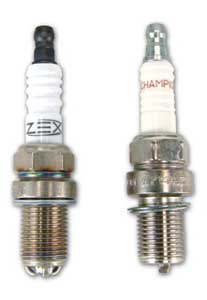 Finding just the right spark plugs for a modified engine is a little more involved than looking in a catalog for make and model.
Finding just the right spark plugs for a modified engine is a little more involved than looking in a catalog for make and model.
Depending on the engine modifications you’ve made, you’ll need to take a few extra factors into consideration before settling on the right spark plugs. These factors include spark plug seat design, thread length and diameter, and reach. One of the most important — and most misunderstood — factors in choosing aftermarket spark plugs is the heat range.
What is Heat Range?
Heat range is the speed at which a spark plug can transfer heat from the firing tip to the cylinder head water jacket and into the cooling system. Choosing the right heat range is crucial for high performance engines. If the heat range is too cold, the spark plug will be unable to properly self-clean by burning off carbon deposits.
If it the heat range is too hot, your engine could experience detonation, pre-ignition, or power loss. Most spark plug manufacturers recommend that the tip temperature remain between 500° C and 850° C.
Heat ranges are designated by each spark plug manufacturer with a number. In broad terms, spark plugs are often referred to as “hot plugs” or “cold plugs.” A cold plug has a shorter insulator nose length—the distance from tip to spark plug shell—and transfers heat rapidly from its firing tip to the cylinder head water jacket.
Cold plugs are ideal for high rpm engines, forced induction applications, and other instances where the engine produces high operating temperatures. Conversely, hot plugs are good for applications that operate mainly at low rpms. Because they have a longer insulator nose length, heat is transferred from the firing tip to the cooling system at slower pace. This keeps the spark plug temperature high, which allows the plug to self clean and prevent fouling.
Unfortunately, heat range numbers are not universal—each brand has its own method for assigning heat ranges. You’ll need to talk with your sales rep or consult with the manufacturer to find the best heat range for your application and spark plug brand. Be prepared to supply some basic vehicle information, including any modifications you’ve made.
As a rule of thumb, you can expect to require one heat range colder than the factory-supplied plugs for every 75-100 horsepower you’ve add with your modifications, according to Champion Spark Plugs. Here are some more basic guidelines to get you pointed in the right direction:
Basic Heat Range Guidelines
• Supercharging/turbocharging: Forced induction leads to increased cylinder pressure and temperature, which could lead to detonation. Depending on the exact application, you’ll need to go with a significantly colder heat range (faster heat transfer) over stock.
• Nitrous oxide: The high cylinder temperatures caused by nitrous usually requires a colder heat range over the stock plug.
• Methanol: Since it has a higher octane level than standard gasoline, methanol delivers more complete combustion. As a result, you’ll need a colder plug to transfer more heat from the combustion chamber.
• Increased compression ratio: Higher compression ratios mean higher cylinder pressure and temperature. Once again, you’ll need a colder heat range to rapidly transfer all that extra heat to the cooling system.
• Air/fuel mixture modifications: Lean air/fuel mixtures raise the operating temperature, along with the plug tip temperature, possibly causing knock or pre-ignition. Use a colder heat range for leaner air/fuel mixtures. Rich air/fuel mixtures can cause the plug temperature to dip, allowing carbon deposits to build up on the tip. Use a hotter heat range for rich air/fuel mixtures.
• Advanced ignition timing: In general, advanced ignition timing will raise the spark plug temperature. In fact, NGK estimates an increase of 70° to 100° for every 10° advance in ignition timing. For this reason, you may need to go with a colder heat range to prevent knock or pre-ignition.
• Prolonged acceleration/high speed driving: Frequent and drawn-out acceleration and high-rpm driving raises combustion temperatures and generally requires a colder heat range.
Tech Tip courtesy of Summit Racing.





